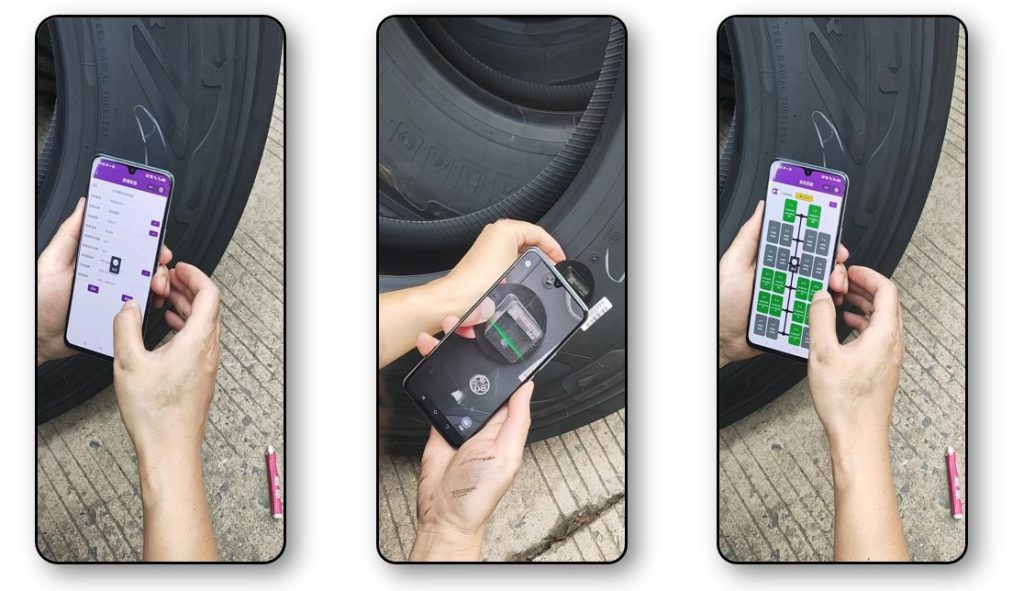In today’s competitive transportation and logistics industries, fleet performance is crucial to a company’s success. One often overlooked aspect of fleet management is tire health, which directly impacts safety, fuel efficiency, and overall operational costs. Thanks to IoT tire management systems, fleet operators can now optimize tire performance through real-time data, predictive maintenance, and automated alerts. In this article, we’ll explore how intelligent tire management platform help enhance fleet performance, reduce costs, and ensure the safety of your vehicles.

How IoT Tire Management and PC-Based Systems Improve Fleet Performance
IoT tire management systems rely on sensors installed within tires, which collect and transmit data to a central platform, often accessible via a PC-based fleet management system. This data includes vital metrics such as tire pressure, temperature, tread wear, and overall tire health. By integrating this information into your fleet management strategy, you can:
- Monitor Tire Health in Real-Time: IoT sensors provide real-time updates on tire conditions, allowing fleet managers to detect issues before they cause costly damage or safety risks. By tracking tire pressure and temperature continuously, fleet operators can optimize tire maintenance schedules and reduce the likelihood of unexpected breakdowns.
- Enhance Predictive Maintenance: Traditional tire maintenance relies on fixed schedules or reactive fixes after issues arise. With IoT, fleet managers can use predictive maintenance to forecast when tires will need attention, reducing downtime and enhancing fleet productivity.
- Automate Alerts and Notifications: PC-based systems integrated with IoT technology can automatically send notifications about critical tire conditions. Whether it’s low pressure, excessive temperature, or significant tread wear, operators receive real-time alerts to address these issues before they impact operations.
Key Benefits of IoT Tire Management Systems for Fleet Safety & Efficiency
Adopting an IoT tire management system offers numerous advantages that can enhance both safety and operational efficiency. Here are five key benefits:
- Improved Fuel Efficiency: Tires that are properly inflated reduce rolling resistance, which directly impacts fuel consumption. An IoT tire management system ensures tires are always at their optimal pressure, helping fleets save fuel and reduce their carbon footprint.
- Cost Savings: By preventing unexpected tire failures and extending tire life through real-time monitoring, fleet managers can significantly cut down on tire replacement costs. Regular, data-driven maintenance reduces the need for costly repairs.
- Enhanced Safety: With automated tire monitoring, fleet managers can address tire issues such as underinflation or excessive wear that might lead to dangerous accidents. This proactive approach helps keep drivers safe and minimizes the risk of road incidents.
- Reduced Downtime: Predictive maintenance powered by IoT systems can prevent tire failures, reducing the chances of unplanned downtime. Fleets can operate more efficiently with fewer disruptions, keeping vehicles on the road longer.
- Improved Fleet Performance Analytics: The data collected by IoT sensors can be analyzed to identify trends in tire performance across your fleet. This data-driven approach allows fleet managers to make informed decisions about tire usage, leading to further cost savings and efficiency improvements.
Real-Time Monitoring of Tire Health
The backbone of an IoT tire management system is its ability to monitor tire health in real-time. Sensors placed within the tires measure various parameters, such as air pressure, temperature, tread wear, and overall tire condition. This data is transmitted wirelessly to the fleet management system, where it is analyzed and displayed on a dashboard for easy interpretation.
Example: A fleet manager receives a notification about low tire pressure on a vehicle. Without this technology, the issue might have gone unnoticed until it led to a flat tire or more severe damage. With IoT sensors, the manager can address the problem immediately, ensuring the vehicle is roadworthy and avoiding costly repairs.
How IoT Helps with Predictive Maintenance
With predictive maintenance, fleet managers can anticipate when tires will need attention, rather than reacting to failures after they occur. IoT sensors track the performance of each tire and analyze trends over time. For example, if a tire begins to show signs of excessive wear, the system will notify the fleet manager, enabling them to replace the tire before it causes an issue that could disrupt operations.
Example: A fleet company implementing IoT tire monitoring notices that certain tires on their vehicles tend to wear out faster in specific road conditions. Armed with this knowledge, they can optimize tire rotations and maintenance schedules to extend the lifespan of each tire.
Cost Benefits of IoT Tire Management
The financial benefits of IoT tire management extend beyond tire replacement costs. With real-time monitoring and predictive analytics, fleets can significantly cut down on fuel expenses, maintenance costs, and downtime. Tires that are properly inflated and well-maintained perform better and last longer, meaning fewer replacements and less risk of costly on-the-road breakdowns.
Additionally, by optimizing tire performance, fleets can reduce fuel consumption. Underinflated tires create more rolling resistance, which forces the vehicle engine to work harder, leading to increased fuel consumption. By keeping tires at their optimal pressure, fleets can save up to 3% in fuel costs annually.
Integrating IoT Tire Management with Fleet Management Software
To maximize the benefits of IoT tire monitoring, it’s essential to integrate the data collected by the sensors into your fleet management software. This allows fleet managers to gain a comprehensive view of their fleet’s tire health, alongside other vital performance metrics like fuel efficiency, driver behavior, and vehicle health.
Fleet management software can also integrate tire data with maintenance scheduling, ensuring that tire replacement and repairs are done proactively. This reduces the burden on fleet managers and ensures that vehicles are always roadworthy, without unnecessary downtime.

FAQs on IoT Tire Management for Fleets
Q: How can IoT tire management reduce fuel costs?
A: By ensuring optimal tire pressure, IoT systems reduce rolling resistance, improving fuel efficiency. Well-maintained tires require less energy to move, saving fleets money on fuel.
Q: Can IoT tire management help with fleet safety?
A: Yes, IoT tire management systems provide real-time alerts for issues like underinflated tires or excessive wear, preventing tire-related accidents and ensuring driver safety.
Q: Is predictive maintenance really effective for fleets?
A: Absolutely. By using data from IoT sensors to predict when tires will need maintenance, fleets can avoid costly breakdowns and downtime, ensuring their vehicles stay on the road longer.
Why IoT Tire Management is a Game Changer for Fleets
IoT tire management systems are revolutionizing how fleets monitor and maintain tire health. By leveraging real-time data, predictive maintenance, and automated alerts, fleet operators can optimize tire performance, reduce costs, enhance safety, and improve overall fleet efficiency. For fleet managers looking to stay ahead of the curve and maximize the performance of their vehicles, integrating IoT tire management is not just an option – it’s a necessity.

